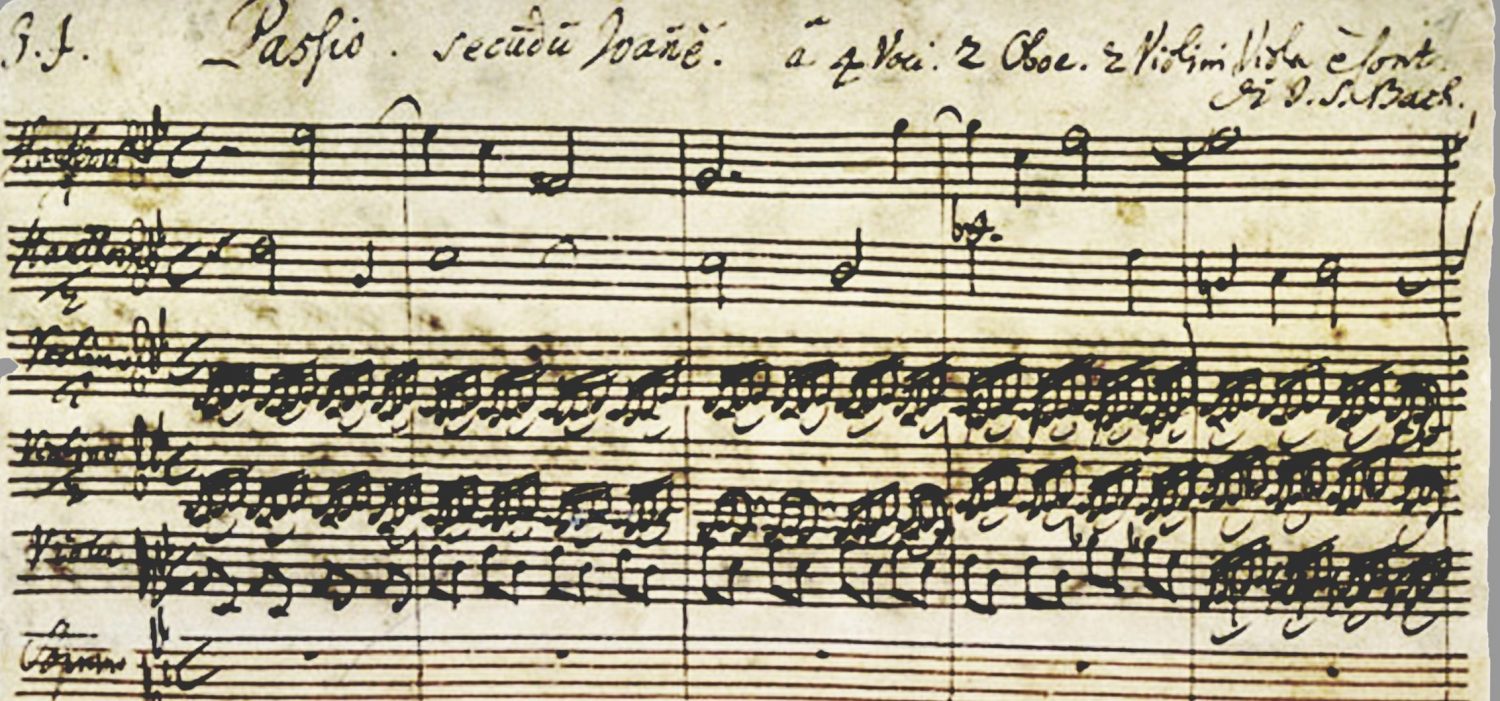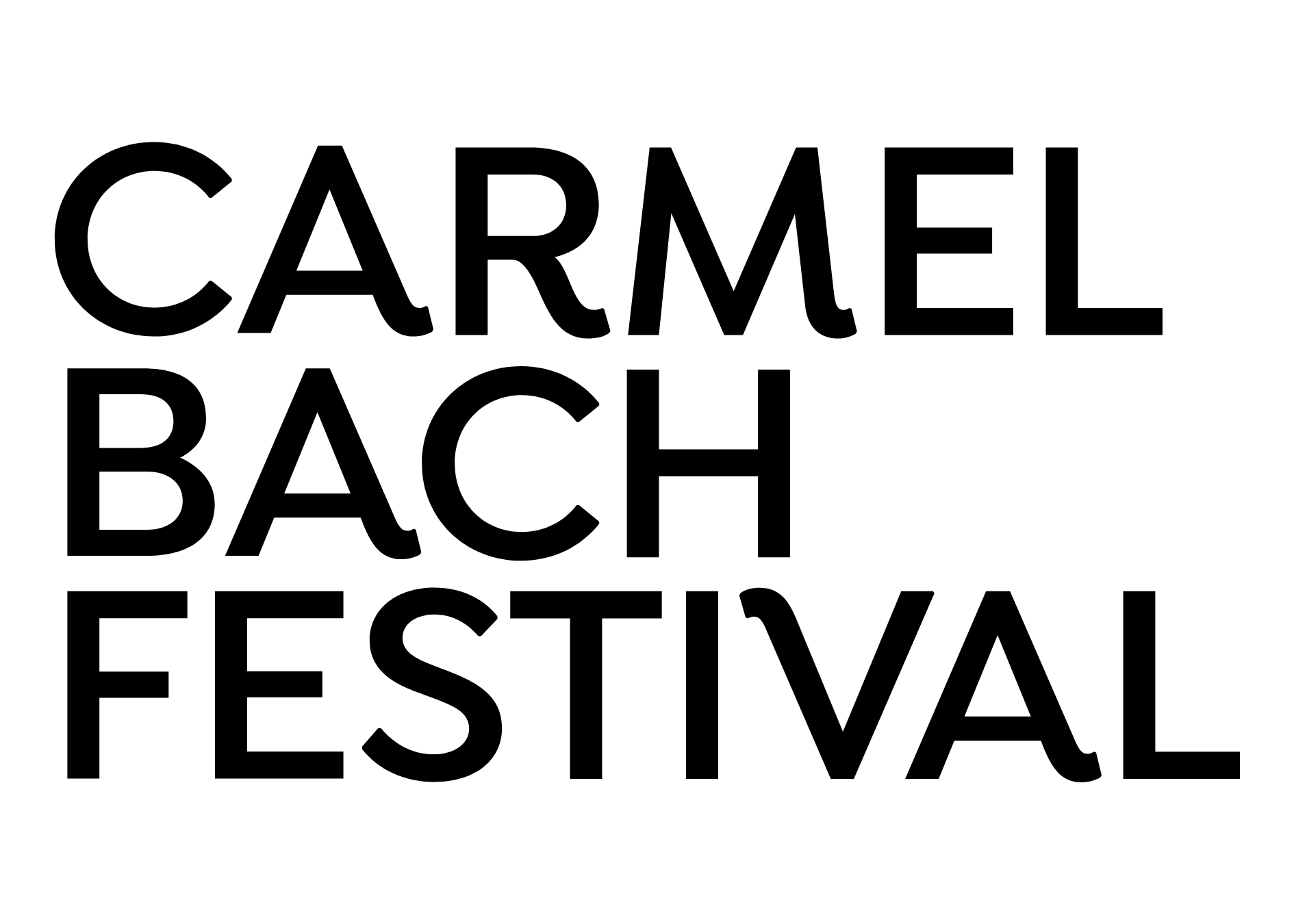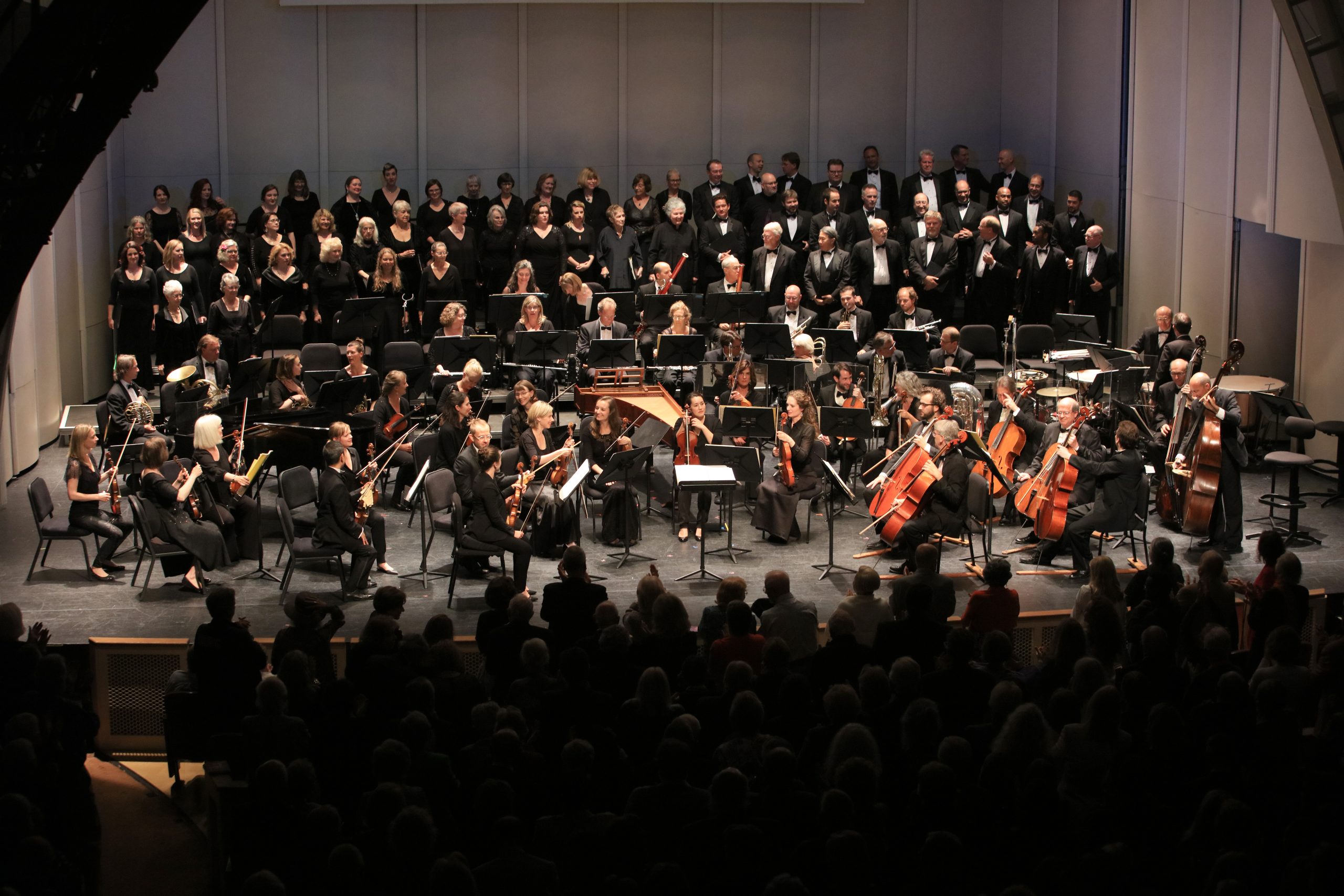
St. John Passion
Sundays, July 17 & 24, 3:00 PM
| Johann Sebastian Bach |
St. John Passion, BWV 245 |
|
(1685–1750) |
Part 1 | 1. Chorus: Herr, unser Herrscher |
| 2a. Recit: Jesus ging mit seinen Jüngern | ||
| 2b. Chorus: Jesum von Nazareth | ||
| 2c. Recit: Jesus spricht zu ihnen | ||
| 2d. Chorus: Jesum von Narareth | ||
| 2e. Recit: Jesus antwortete | ||
| 3. Chorale: O große Lieb | ||
| 4. Recit: Auf daß das Wort erfüllet würde | ||
| 5. Chorale: Dein Will gescheh, Herr Gott, zugleich | ||
| 6. Recit: Die Schar aber und der Oberhauptmann | ||
| 7. Aria: Von den Stricken meiner Sünden | ||
| 8. Recit: Simon Petrus aber folgete Jesu nach | ||
| 9. Aria: Ich folge dir gleichfalls | ||
| 10. Recit: Derselbige Jünger war dem Hohenpriester bekannt | ||
| 11. Chorale: Wer hat dich so geschlagen | ||
| 12a. Recit: Und Hannas sandte ihn gebunden | ||
| 12b. Chorus: Bist du nicht seiner Jünger einer | ||
| 12c. Recit: Er leugnete aber und sprach | ||
| 13. Aria: Ach, mein Sinn | ||
| 14. Chorale: Petrus, der nicht denkt zurück |
| Intermission |
| Part 2 | 15. Chorale: Christus, der uns selig macht | |
| 16a. Recit: Da führeten sie Jesum | ||
| 16b. Chorus: Wäre dieser nicht ein Übeltäter | ||
| 16c. Recit: Da sprach Pilatus zu ihnen | ||
| 16d. Chorus: Wir dürfen niemand töten | ||
| 16e. Recit: Auf daß erfüllet würde das Wort | ||
| 17. Chorale: Ach großer König | ||
| 18a. Recit: Da sprach Pilatus zu ihm | ||
| 18b. Chorus: Nicht diesen, sondern Barrabam | ||
| 18c. Recit: Barrabas aber war ein Mörder | ||
| 19. Arioso: Betrachte, meine Seel | ||
| 20. Aria: Erwäge, wie sein blutgefärbter Rücken |
Artists: Festival Orchestra, Chorale, and Soloists; Clara Rottsolk, soprano; Meg Bragle, mezzo-soprano; Thomas Cooley, tenor; Dashon Burton, bass-baritone; conducted by Andrew Megill
Program Notes
Bach had served as Cantor in Leipzig for barely a year when he unveiled his St. John Passion on Good Friday, 1724 in the Nicolaikirche. Parts of this work may have been composed earlier in Cöthen or even in Weimar, but most of the music was created especially for the occasion. Although musical settings of the Passion had been evolving for centuries, the oratorio Passion — comprised of the biblical texts enhanced by poetic arias and chorales meant to surround the sermon on one of the most important days in the liturgical calendar — was relatively new in Leipzig, having been introduced only a few years earlier. Bach’s Passion settings were the apex of this progression, never to be surpassed. In subsequent performances, Bach made changes and substitutions to the St. John Passion, resulting in four different versions, but the work’s final form in large part conforms to its first.
An unknown librettist (possible Bach himself) drew the biblical text recited by the Evangelist from Luther’s translation of John 18 and 19, and some portions of Matthew. The choruses and arias, which provide commentary and poetic contemplation, have texts taken mainly from the 1712 poem Der für die Sünden der Welt gemarterte und sterbende Jesus (Jesus Tortured and Dying for the Sins of the World) by B. H. Brockes, as well as other sources. Interspersed between the biblical narrative and the poetic commentary are the chorales, meant to embrace the congregation on familiar terms, derived from traditional Lutheran hymnals of previous centuries.
Bach’s only other fully intact Passion setting, the Saint Matthew — on a larger scale and employing greater forces — came three years later, and was the first to be revived a century later thanks to the efforts of Felix Mendelssohn. Both versions of the Passion tell the familiar story but differ in their tone and emphasis. Because of its relative brevity, the action in St. John moves more swiftly, and its text comes across as more visceral, the emotions more raw. A characteristic of the St. John Passion often noted is its apparent anti-Semitic stance: the vicious crowds demanding Jesus’ execution are continually referred to as “The Jews,” whereas Pilate is portrayed as a passive, even reluctant participant. Bach does not soften this perception in his treatment, being faithful to this particular biblical text, but rather dramatizes it to the fullest. It is worth noting, however, that the poetry chosen from more contemporary sources for arias does not support such prejudice.
Part One concerns the betrayal and arrest of Jesus. The opening chorus, Herr, unser Herrscher (Lord, our Master) is a hymn of praise, but in an atmosphere of despair, with continuous, agitated sixteenth notes simmering under oboes clashing like unresolved cries of anguish. The Evangelist begins the story of the Passion in recitative. The other principal sung characters are Jesus, Peter, Pilate, maid, and servant. Jesus is represented with a bass voice, but without the halo of string chords found in Saint Matthew. Even in the recitatives, musical effects are used to heighten the drama. Notice the sharp harmonic turn at the first mention of Judas, and the difference between the simple cadence when Jesus states Ich bins (I am he) and the false sounding Ich bin’s nicht when Peter denies being a disciple. The crowing of the cock is followed by a painful depiction of Peter’s remorse, the words weinete bitterlich (wept bitterly) drawn out with a weirdly unstable, chromatic bass line.
Part One has three contrasting arias: Von den Stricken meiner Sünden (To free me from the bond of my sin), for alto, is musically related to the opening chorus, the cheerful soprano aria Ich folge dir (I follow you), with light footsteps in the bass and musical play on the words schieben (push) and ziehen (pull), and finally the anguished tenor aria Ach, mein Sinn (O my sin) — with jagged rhythms and chromatic harmony already glimpsed in the preceding recitative — reflecting Peter’s guilt.
Part Two, which in Bach’s time would have followed the sermon of the day, concerns the trial of Jesus, his condemnation, and execution. After an introductory chorale and the beginning of Pilate’s interrogation, Bach presents the ensuing events in a sequence of numbers [17-26] as a kind of arch form, with the chorale Durch dein Gefängnis, (Through your imprisonment) as the keystone of the structure and the chorales Ach grosser König (O mighty king) and In meines Herzens Grunde (In my heart’s fundament) serving as outer frames. On either side of the center, there are arias and two sets of corresponding choruses. This structure is, of course, obscured by the increasing drama and intensified emotions. Two of the choruses reflect the savagery of the crowd with the rhythm of the word Kreuzige (Crucify); the other two resemble a minuet (associated with royalty) in an ironic, mocking way: Sei gegrüßet, lieber Jüden könig (Hail, King of the Jews!), and Schreibe nicht: der Jüden König.
Mercurial emotions are inspired by Bach’s rich palette of word painting. After the crowd demands that Barabas the thief, not Jesus, be released, the flagellation is graphically depicted in the continuo, while the Evangelist wildly traces the word geißelte (flogged). In startling contrast, the serene arioso Betrachte, meine Seel (Consider, my soul) follows, with the ethereal sound of two violas d’amore and lute. Then the unique tone color of these instruments is used to an altogether different effect in Erwäge, wie sein blutgefärbter Rücken (Look how his bloodstained back). But even here, the violent imagery is turned around in the middle section, when the tenor sings of a Regenbogen (Rainbow) as the instruments construct a beautiful arch. The aria Eilt, ihr angefochten Selen (Hurry, you tormented souls) contrasts the hastily ascending scales in the solo bass on Flieht (fly) with the uncertainty of the crowd on Wohin? (Where?).
The final events in the Passion then proceed according to prophecy, confirmed by the final words of Jesus on the cross Es ist vollbracht! (It is accomplished!). Throughout, Bach carefully guides the reactions and commentary on the story. Those last words are set simply with four notes, which form the basis for elaboration in a poignant aria for alto solo and viola da gamba obbligato. The choice of that instrument, not normally a part of the orchestra at this time, was not taken lightly; Malcolm Boyd states that the viola da gamba was associated with the “sweetness of death” in Lutheran ideology. Also significant to that faith is the symbolism of the animated middle section in D Major, singing of heroic victory in a key associated with resurrection. That is cut short, returning to Es ist vollbracht, and in another surprise, the singer has the last word.
The moment of Christ’s death is depicted plainly, followed by the comforting bass aria Mein teuer Heiland (My dearest Savior), juxtaposing a relaxed, gigue-like melody and cello line with a softly intoned chorale. The earthquake, borrowed from the text of Saint Matthew, breaks out in the recitative, with aftershocks in the strings in an arioso that sets up the final aria, Zerfliesse, mein Herze (Dissolve, my heart). Sobbing and flowing tears are suggested by the instruments in this dark piece. Its tonality of F Minor, a traditional key of mourning, continues in the following chorale. The final chorus, Ruht wohl (Rest well) is, like its equivalent movement in the Saint Matthew Passion, a grieving lullaby. But in this work, so full of such contrasts that speak to the human condition and need for emotional connection, Bach reaches out a final time to the congregation — that is, to us — offering a chorale of solace and hopeful closure.
All over the world, performances of Bach Passions were cancelled due to safety concerns during the pandemic. More than ever, today’s live performance of the St. John Passion should provide spiritual nourishment for musicians and audiences alike.
—Allen Whear
THOMAS COOLEY tenor
Minnesota-born tenor Thomas Cooley has established a reputation on both sides of the Atlantic—and beyond—as a singer of great versatility, expressiveness, and virtuosity. Possessing a lyric tenor voice of great flexibility, dynamic range, and precision
Cooley studied at DePauw University, the University of Minnesota and the Richard Strauss Conservatory. He is an Artist in Residence with Chicago’s Music of the Baroque. This season marks Thomas’ 11th in Carmel. Thomas will perform the role of the Evangelist in the St. John Passion.
MEG BRAGLE mezzo-soprano
Mezzo-soprano Meg Bragle returns for her fourth Carmel Bach Festival season as a soloist. She was a Virginia Best Adams fellow in 1999. Widely praised for her musical intelligence and “expressive virtuosity,” Meg has earned an international reputation as one of today’s most gifted and versatile mezzo-sopranos. She is the recipient of awards and recognition from Symphony Magazine, the American Bach Society, and the Bethlehem Bach Festival. A frequent featured soloist with Sir John Eliot Gardiner and the English Baroque Soloists, she has made four recordings with the group.






